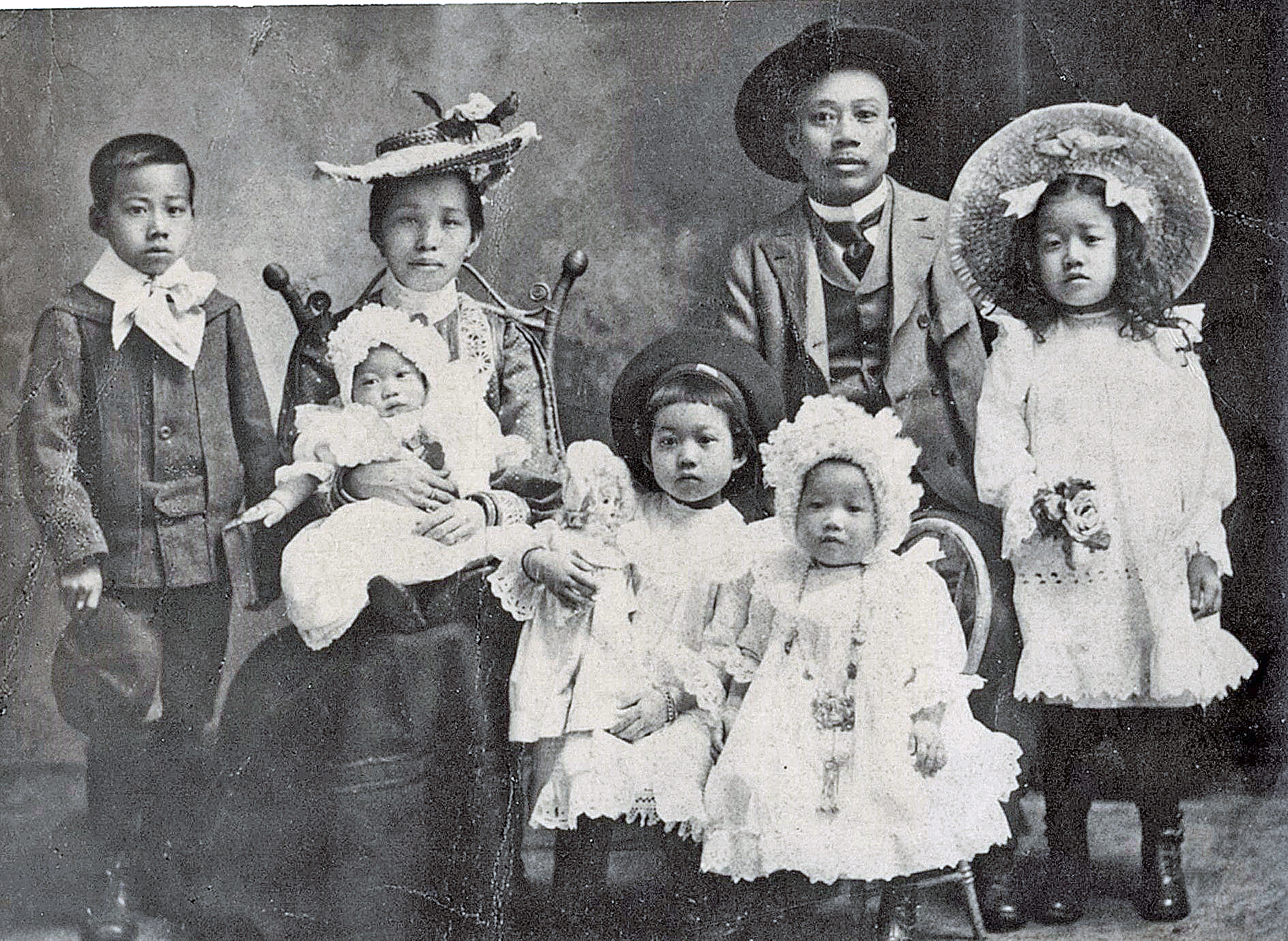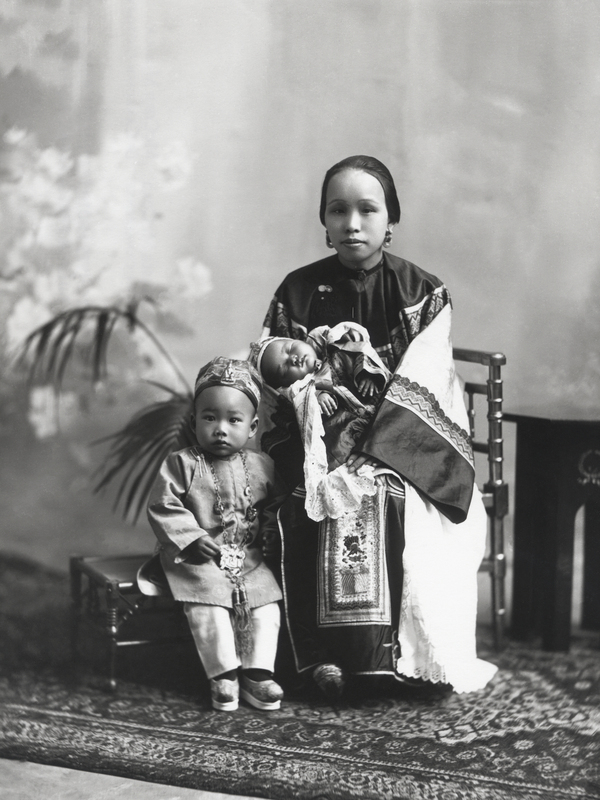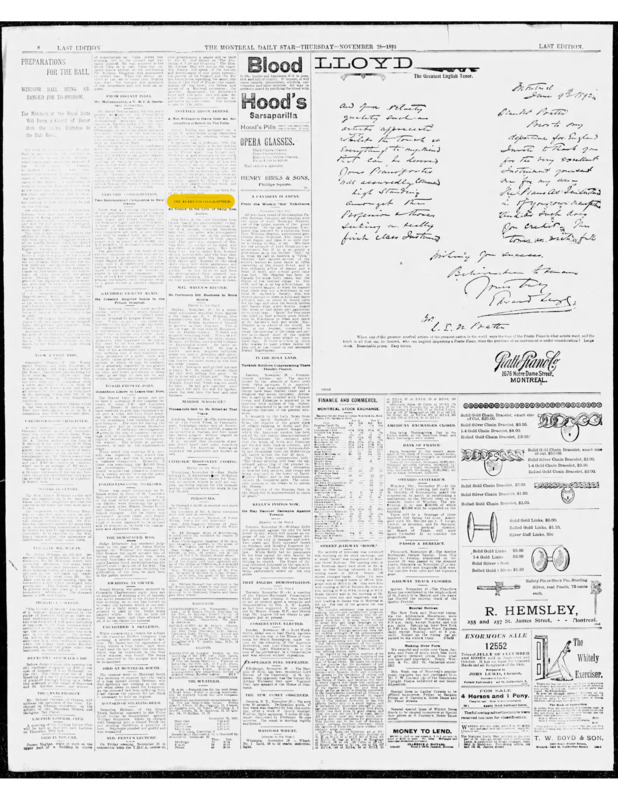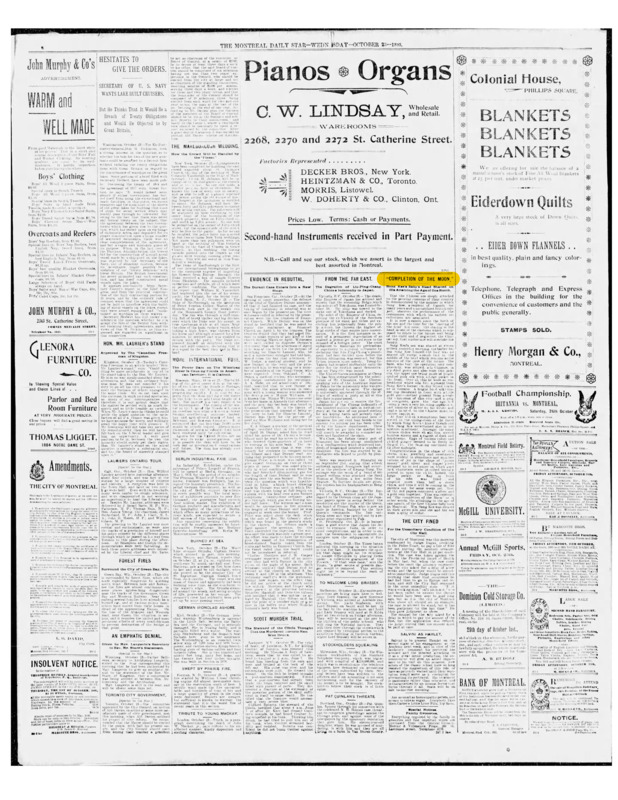George Sang Kee, 1895-1908
Contents: English | 漢語 | Français | Sources 來源 | Images 圖片
English
George “Georgie” Sang Kee (1895-1908): Dreaming Childhood in Early Chinese Montreal
Son - Scholar
By Camille Lopez
George Sang Kee was born on September 29, 1895, to Ho (Haw) Sang Kee and Chu Shee, a prominent Toysanese couple in Montreal, Canada. Described by Edith Eaton in the Montreal Daily Star as “the first pure Chinese child ever born in this city,” the infant George received notable attention from the press, a fact indicative not only of his father’s status as a successful business owner and prominent figure in the Chinese community, but also of the novelty of more domestic Chinese life in a community comprised almost exclusively of men (“A Chinese Child Born”). George’s mother, referred to in contemporaneous newspapers as “Miss Chu Shee”, sometimes “Miss Chu See,” and later as “Mrs. Ho Sang Kee” or “Mrs. Sam Kee,” travelled as a bride-to-be from China to Montréal in Fall 1893. Two years later, George was born in Ho Sang Kee’s hotel on rue de la Gauchetière West, at the very heart of what would eventually become the city’s Chinatown.
From the moment of his birth, George did not want for companions or caretakers. Chu Kee, a girl recorded in the Register of Chinese Immigrants to Canada, 1886-1949 as “Jew Guey,” would have been present at the intimate gathering to celebrate Sang Kee’s newborn son that day on rue de la Gauchetière. While a number of newspapers refer to Chu Kee as Mrs. Sang Kee’s “slave girl,” Eaton notes that the Chinese customarily “look[ed] upon slaves as family” (“Girl Slave in Montreal”). Indeed, an 1893 issue of The Montreal Star identifies Chu Kee as Sang Kee’s “little eight-year-old daughter” (“Sang Kee and Miss Chu See”). In addition to the sister role that Chu Kee likely stepped into as an older child in the family, George would have also grown up among the many associates and acquaintances of the Ho Sang Kee household. Wing Sing and his wife, in particular, appear in the news as close friends of the family, and in a publicized event of an otherwise private affair, one visiting friend from Boston, referred to as “Mrs. Moy Dong Fat,” is seen accompanying Mrs. Ho Sang Kee, Chu Kee, and George to have their family photographed. George eventually gains five sisters and brothers: Avis, Charlie, Grace, Florence and Henry. Between his proud father and mother, their growing family, and a remarkable, transnational network of friends and associates who frequented their home, George Ho Sang Kee would have found himself in a world of thriving kinships, both familial and otherwise.
Living with his father, mother, and Chu Kee on the top floor of their boarding house, George’s early years unfolded in peculiar contradiction, at once isolated and communal, intimate and public. Days and nights would have been punctuated with the clatter and bustle of boarders just a floor below – Ho Sang Kee relegated the sleeping quarters of his hotel to the second floor, while the first floor hosted a Chinese shop with “eating and lounging rooms” (“The Chinese Colony”). Beyond the boarding house, George’s life as one of the few Chinese children in Montreal would not have proved a simple existence. Recounting the experiences of mixed Chinese North American children in the late nineteenth century, Eaton recalls one boy being “persecuted for nearly an hour by a crowd of roughs” (“Half-Chinese Children”). While his own reception as a purely Chinese child is unclear, representations of George in Montreal newspapers paid special attention to the “peculiar customs” which marked George’s foreignness as the first Chinese infant in the city (“‘Completion of the Moon’”). Yet even in the news, George Ho Sang Kee emerges as a liminal figure, the “only Canadian born Chinese baby,” who at one moment is “dressed in the conventional attire of a common, everyday American baby” (“The Baby Photographed”) and at another appears clothed “à la Chinoise, in a padded gown and . . . two jackets . . . made of bright quilted pink silk” (“‘Completion of the Moon’”).
George Ho Sang Kee was the recipient of a rich cultural inheritance. At one month old, he had his hair shaved according to Chinese custom. In the years that followed, George would have crawled and toddled along the rooms of the boarding house with the beginnings of a queue on his head. No elementary schools for Chinese children existed in the city. Instead, Chinese language school took place after school at the Chinese Presbyterian Church, where George would have learned Cantonese. George performed remarkably well at school, winning several prizes and often achieving top of his class. In keeping with the general trend of the Chinese in Montreal, Chu Shee showed little interest in the Christian religion. George’s Christian baptism is recorded in the register of Knox Church a little more than a week before his death in 1908.
George was admitted to the Children’s Memorial Hospital and passed away at the age of twelve on March 3, 1908, after having stayed at the hospital “for some time” (“Death of Chinese Boy”). Though the cause of death is uncertain, it is possible he contracted an illness in the winter months. George’s death in March was followed by the death of his mother in July. He is buried next to her in Mount Royal Cemetery.
漢語
George “Georgie” Sang Kee: 蒙特利爾早期華人的夢想童年
兒子 - 學者
寫的Camille Lopez
喬治桑基於 1895 年 9 月 29 日出生於蒙特利爾的桑基夫婦。加拿大華裔作家伊迪絲·伊頓在《蒙特利爾星報》中被描述為“這個城市出生的第一個純中國孩子”,嬰兒時期的喬治受到了媒體的廣泛關注,這不僅表明了他父親作為成功企業主的地位,而且華人社區中的傑出人物,但也體現了在幾乎完全由男性組成的社區中更多中國家庭生活的新穎性(“一個中國孩子出生”)。喬治的母親,在同時代的報紙上以她的姓氏(“朱氏小姐”)稱呼,後來被稱為“喬治夫人”。何生記”或“夫人。 1893 年底,Sam Kee 以準新娘的身份從中國旅行到蒙特利爾。兩年後,George 出生在 Sang Kee 位於 Lagauchetière Street West 的酒店,該酒店位於最終成為蒙特利爾唐人街的中心地帶。
從他出生的那一刻起,就不需要同伴或看護人。 1886-1949 年在加拿大華人移民登記冊上被記錄為“Jew Guey”的 12 歲女孩 Chu Kee 本來會出席那天在 Lagauchetière 慶祝 Sang Kee 剛出生的兒子的親密聚會。雖然許多報紙將朱記稱為桑記夫人的“女奴”,但伊頓指出,中國人習慣上“視奴隸為家人”(“蒙特利爾女奴”)。事實上,《蒙特利爾之星》的一期將朱琪描述為桑琪的“八歲小女兒”(“桑琪和朱詩小姐”)。除了朱記可能作為家中的長女扮演姐姐的角色外,喬治還會在朱記家族的眾多同事和熟人中長大。尤其是 Wing Sings,他們作為家人的親密朋友出現在新聞中,並且在一次公開事件中,另一位來自波士頓的來訪朋友,被稱為“夫人”。 Moi Dong Fat”陪同生琪、朱琪和George合影。在驕傲的父親和母親、姐妹形像以及經常光顧他們家的卓越的跨國朋友和同事網絡之間,George Sang Kee 會發現自己置身於一個充滿親情和其他親情的世界。
喬治與他的父親、母親和朱基住在他們寄宿公寓的頂層,早年在奇特的矛盾中展開,既孤立又公共,既親密又公開。白天和黑夜都會被下一層寄宿生的嘈雜聲和喧囂所打斷——桑基將他酒店的臥室降級到二樓,而一樓則設有一家中國商店,裡面有“餐廳和休息室”(“中國殖民地”)。除了寄宿家庭,作為蒙特利爾為數不多的華人孩子之一,喬治的生活也不會簡單。在講述 19 世紀後期北美華裔混血兒的經歷時,伊頓回憶起一個男孩“被一群野蠻人迫害近一個小時”(“半個中國孩子”)。作為一個純中國孩子,他在加拿大是如何被接納的尚不清楚,但蒙特利爾的報紙特別關注了“特殊習俗”,這標誌著喬治作為該市第一個中國嬰兒的外國身份(““月亮完成””) .然而,即使在新聞中,George Sang Kee 也只是一個邊緣人物,“唯一在加拿大出生的華人嬰兒”,曾一度“穿著普通美國嬰兒的傳統服裝”(“被拍到的嬰兒”)在另一個人看來,穿著“à la Chinoise”,穿著一件帶襯墊的長袍和。 . .兩件夾克。 . .由亮粉色絎縫絲綢製成”(“‘月圓’”)。
George Sang Kee 是豐富文化遺產的接受者。一個月大時,他按照中國習俗剃了頭髮。在接下來的幾年裡,喬治會在寄宿公寓的房間裡爬來爬去,頭上頂著長隊。當喬治到了學齡時,城裡還沒有華人兒童小學,最早的小學是在 1900 年至 1930 年之間的某個時候建立的。目前還不清楚喬治上過哪所學校,也不清楚他是用法語還是英語學習課程。儘管如此,喬治在學校的表現非常出色,贏得了多項獎項,並且經常取得班上第一名的成績。
喬治被送往兒童紀念醫院並於 1908 年 3 月 3 日去世,享年 12 歲,此前他在醫院“住了一段時間”(“中國男孩之死”)。雖然死因不明,但有可能是在冬季染病。順應蒙特利爾華人的普遍趨勢,他的母親對基督教沒有什麼興趣,所以喬治直到1908年去世前一周多一點才受洗,記錄在諾克斯教堂的名冊上。喬治於三月去世,隨後他的母親於七月去世。他被安葬在皇家山公墓的她旁邊。
Français
George « Georgie » Sang Kee : Enfance rêvée dans le Montréal des premiers Chinois
Fils - Élève
Par Camille Lopez
George Sang Kee nait le 29 septembre 1895 de Ho Sang Kee et Chu Shee, un couple Toysanese très en vue. Décrit par l’auteure sino-canadienne Edith Eaton dans le Montreal Daily Star comme « le premier enfant totalement chinois né dans cette ville », George reçut une attention particulière de la part de la presse, ce qui indique non seulement le statut de son père en tant que propriétaire d’entreprise prospère et figure de proue de la communauté chinoise, mais indique aussi une nouvelle vie chinoise plus domestique dans une communauté composée presque exclusivement d’hommes (« A Chinese Child Born »). Sa mère, mentionnée dans les journaux contemporains par son nom de famille (« Miss Chu Shee ») et plus tard comme « Mme Ho Sang Kee » ou « Mme Sam Kee », a voyagé de Chine à Montréal à la fin de 1893 en tant que future mariée. Deux ans plus tard, George est né à l’hôtel de Ho Sang Kee, rue de la Gauchetière Ouest, au cœur même de ce qui deviendra plus tard le quartier chinois de Montréal.
Dès sa naissance, George n’a pas voulu de compagnons ou de gardiens. Chu Kee, une fillette inscrite au Registre des immigrants chinois au Canada, 1886-1949, sous le nom de « Jew Guey », aurait été présente à la réunion intime pour célébrer le fils nouveau-né de Ho Sang Kee ce jour-là, la rue de la Gauchetière. Alors qu’un certain nombre de journaux désignent Chu Kee comme la « fille esclave de Mme Sang Kee », Eaton note que les Chinois ont l’habitude de « considérer les esclaves comme une famille » (« Fille esclave à Montréal »). En effet, en 1893 un numéro du Montreal Star présente Chu Kee comme la «fille de huit ans» de Ho Sang Kee («Sang Kee et Miss Chu See»). En plus du rôle de sœur que Chu Kee a probablement assumé en tant qu’enfant la plus âgée de la famille, George aurait également grandi parmi les nombreux associés et connaissances de la famille Ho Sang Kee.
Les Wing Sing, en particulier, apparaissent dans les nouvelles en tant qu’amis proches de la famille, et lors d’un événement médiatisé d’une affaire par ailleurs privée, une ami en visite de Boston, appelé « Mme Moy Dong Fat », est vue accompagnant Chu Shee, Chu Kee et George pour faire photographier leur famille. George finit par avoir cinq frères et sœurs : Avis, Charlie, Grace, Florence et Henry. George Ho Sang Kee s’est retrouvé dans un monde de liens de parenté florissants, à la fois familiaux et autres, notamment grâce à la fierté de ses parents, leur famille grandissante et un remarquable réseau transnational d’amis et d’associés qui fréquentaient leur maison.
Vivant avec son père, sa mère et Chu Kee au dernier étage de leur pension, les premières années de George se sont déroulées dans une contradiction particulière, à la fois isolée et communautaire, intime et publique. Les jours et les nuits auraient été rythmés par le fracas et l’agitation des pensionnaires vivant juste un étage en dessous–Sang Kee reléguait les dortoirs de son hôtel au deuxième étage, tandis que le premier étage abritait un magasin chinois avec des « salles à manger et des salons » (« The Chinese Colony »). Au-delà de la pension, la vie de George en tant que l’un des rares enfants chinois de Montréal n’aurait pas été simple. Racontant les expériences d’enfants mixtes chinois nord-américains à la fin du XIXe siècle, Eaton se souvient qu’un garçon avait été « persécuté pendant près d’une heure par une foule de brutes » (« Half-Chinese Children »). Bien que l’accueil réservé à George en tant qu’enfant purement chinois au Canada n’est pas claire, les journaux de Montréal ont accordé une attention particulière aux « coutumes étranges » qui ont marqué l’aliénation de George en tant que premier enfant chinois de la ville (« Completion of the Moon »). Pourtant, même dans les nouvelles, George Ho Sang Kee apparaît comme une figure liminaire, le « seul bébé chinois né au Canada », qui à un moment donné est « vêtu de la tenue conventionnelle d’un bébé américain ordinaire » (« The Baby Photographed ») et à un autre apparaît habillé « à la Chinoise, dans une robe rembourrée et . . . deux vestes. . . en soie rose matelassée brillante »(« Completion of the Moon »).
George Ho Sang Kee reçut un riche héritage culturel. A l’âge d’un mois, il se fait raser les cheveux selon la coutume chinoise. Dans les années qui ont suivi, George aurait rampé et trottiné dans les chambres de la pension avec un début de queue de cheval sur la tête. Il n’existait pas d’école primaire pour les enfants chinois dans la ville. Au lieu de cela, l’école de langue chinoise se déroulait après l’école à l’église presbytérienne chinoise, où George aurait appris le cantonais. George réussit remarquablement bien à l’école, remportant plusieurs prix et se classant souvent premier de sa classe. Conformément à la tendance générale des Chinois de Montréal, Chu Shee montre peu d’intérêt pour la religion chrétienne. Le baptême de George est inscrit dans le registre de l’église Knox un peu plus d’une semaine avant son décès en 1908.
George est admis au Children’s Memorial Hospital et meurt à l’âge de douze ans le 3 mars 1908, après avoir séjourné à l’hôpital « pendant un certain temps » (« Death of Chinese Boy »). La cause du décès est incertaine, mais il est possible qu’il ait contracté une maladie pendant les mois d’hiver. La mort de George en mars est suivie par celle de sa mère en juillet. Il est enterré à côté d’elle au cimetière du Mont-Royal.
Sources 來源
Anderson, Delaney. “Sang Kee: At the Heart of Montreal’s Early Chinese Community.” Chinese Canadians: Recovering Early Chinese Canadian Literature and History, 19 Feb 2023. https://blogs.ubc.ca/chinesecanadians/2023/02/19 sang-kee-at-the-heart-of-montreals-early-chinese-community-by-delaney-anderson/
“Death of Chinese Boy.” The Montreal Gazette, 5 Mar 1908: 3.
Eaton, Edith (Unsigned). “Completion of the Moon.” Montreal Daily Star, 23 Oct 1895: 6.
—. “Another Chinese Baby. The Juvenile Mongolian Colony in Montreal Receives Another Addition – It Is a Girl and There Are Schemes for Her Marriage.” Montreal Daily Star. 12 Oct 1895: 6.
—. “A Chinese Child Born. At the Hotel on Lagauchetiere Street.” Montreal Daily Star. 30 Sept 1895: 1.
—. “Girl Slave in Montreal. Our Chinese Colony Cleverly Described. Only Two Women from the Flowery Land in Town.” Montreal Daily Witness. 4 May 1894: 10.



